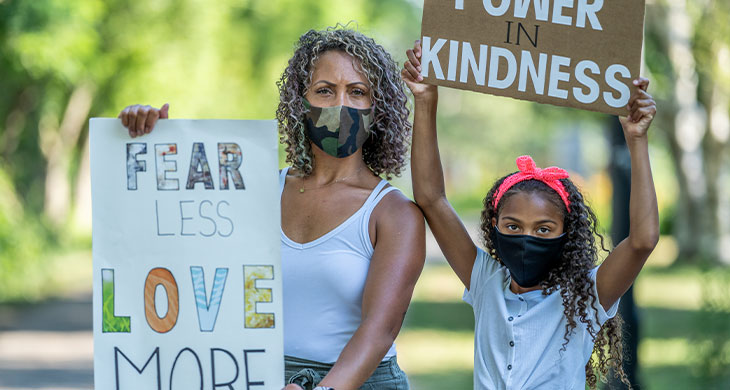Recently, more and more kids have been speaking up and adding their voices to public protests. From deep racial injustice to school shootings to global warming, these pressing issues are affecting children now more than ever before. Subsequently, kids and teenagers have taken it upon themselves to advocate for change.
For example, Aalayah Eastmond, a Parkland school shooting survivor, now leads Black Lives Matter protests in Washington, D.C. The 19-year-old says she refuses to stay silent.
Even little ones who don’t fully understand the negative implications of these issues are gathering with adults to hold posters, walk with protesters, and join in their chants. As a parent, you’ll want to embolden and encourage your kids to speak up and use their voices. However, you likely still worry about their safety, especially considering the use of violence often used against protesters and the surge in COVID-19 cases in the U.S. Fortunately, there are numerous ways to safely encourage your children’s involvement in protests and help them become little advocates for change.
Talk to Them
Often, parents underestimate how much information children can handle, especially regarding the recent protests. After all, many have turned violent. However, kids can tell when something is amiss. As a result, your little one may begin asking questions. Answer them truthfully and honestly, asking follow-up questions to see how much they already know. Then, keep them updated on new developments and explain current issues in a way they’ll understand, using analogies when necessary. Engaging in candid discussions about workplace injustice with your kids is one of the best ways to introduce current issues and discover how they really feel about them. Be sure to ask them how certain situations make them feel and inquire as to how they might want to get involved.
Make Posters
If you and your child decide to attend a protest or simply want to decorate your yard with signs, consider making posters together. Look at other protests for inspiration or write sentiments that will let those afflicted know you are allies. If your child can’t read yet, have them color a poster or help you decorate it with glitter, stickers, and other fun craft supplies. On the other hand, if they are old enough to read and write, ask them what they want to write on their poster. Discuss different options and be ready for more open conversations, as this may spark deeper discussion.
Host a Kid Protest
Often, public protests are loud and can be frightening for young children. Moreover, some may be downright unsafe, especially recent Black Lives Matter protests that have involved mace, tear gas, and other disturbing incidents. In light of this and the coronavirus, you may want to protect your children by keeping them away from large gatherings and protests—at least for now. In the meantime, you and the kids can protest peacefully within your neighborhood. Walk around together like one family in Seattle did or lead a protest with all the kids in the neighborhood. Parade around the block with your posters and signs, and be sure to wear masks and social distance if you have a good turnout.
Use Chalk
Alternatively, you and the kids could skip the poster making and chalk up your sidewalks instead. Start in your neighborhood and use relevant phrases to chalk up the sidewalks and streets. You might also host a kids’ chalk protest like the one in Evansville, Indiana, that occurred in early June. Instead of marching around with signs and megaphones, children and parents gathered in front of the Ford Center and let their drawings do the talking. Create a Facebook event, and spread the word about your chalk protest so as many kids as possible show up to decorate the streets.
Go Online
If you aren’t comfortable gathering with others due to COVID-19 or are simply looking for another way in which your little ones might get involved, turn to the virtual world. There are a plethora of online educational resources, as well as organizations, that could use your support. Check websites that advocate for your cause and determine ways in which you might help. For instance, you might simply sign a petition or donate to the cause online. However, you can also get creative and host a fundraiser for a particular organization. Set up the classic lemonade stand or make masks or other items to raise money for a certain movement. Letting your kids run these operations will allow them to get involved and see the difference they’re making.
Speak up Together
Of course, the best way to support your child is to speak up with them, and stand by their side, as they use their voice for the better. Although they are small, they can still make a huge difference. Besides, if they want to create a safer, more inclusive world for themselves and their peers, who are we to stop them? By finding ways to let them voice their concerns and express their opinions, we can help them advocate for change and make a long-lasting impact on our communities—and the world.






















































































































